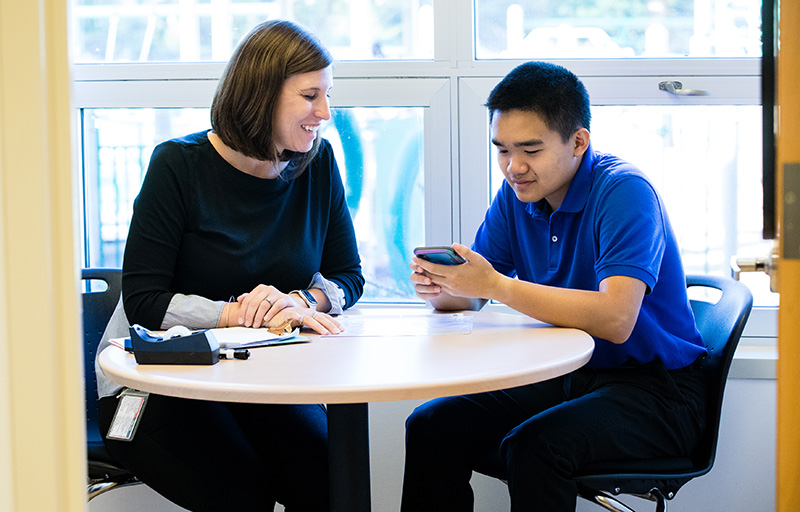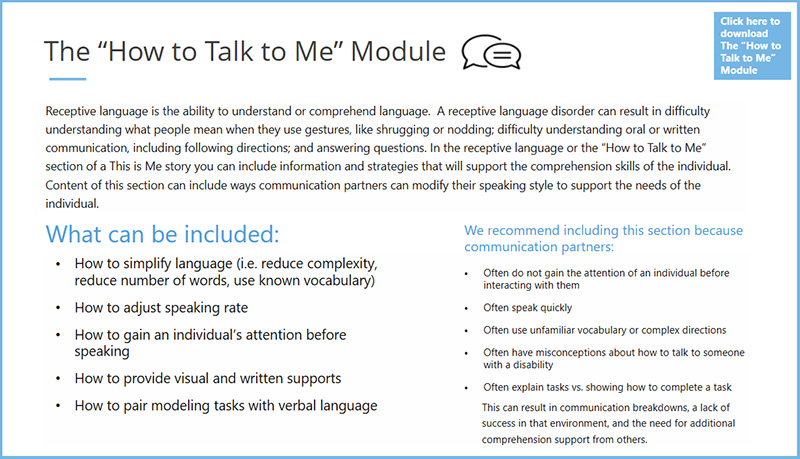For young adults with autism spectrum disorders (ASD)1, transition to post-school life brings with it both new opportunities and new challenges. The transition to post-secondary education settings, vocational programs, community-based day programs, and/or supported living means having to teach all the new adults in their lives about their unique strengths and needs. But transition can be chaotic, and valuable information about how they can be supported to communicate clearly and effectively, manage difficult behaviors, improve executive function, and advocate for support if needed often gets lost in the shuffle.

An Ivymount student practices sharing his This is Me (TiME) story with his speech-language therapist
(and original developer of TiME stories), Danielle Pouliot Evans
Gathering information about individuals with ASD – what works and what doesn’t – takes time, sometimes years of trial and error, and when this information is not passed along in a meaningful format from students’ schools to their post-school settings, young adults and their new support staff are forced to reinvent the wheel.
A great way to avoid this problem and ensure a seamless transfer of information during secondary transition is by working with young adults with ASD to create and share their digital transition portfolios (e.g., Black, 2010; Clancy & Gardner, 2017; Müller et al., 2018; Müller et al., under review; Pouliot et al., 2017). Digital transition portfolios are especially effective because they not only help avoid the loss of critical information during the transition process but also allow young adults with ASD to share information about themselves with minimal support from job coaches and other service providers.
This is Me Stories
A team of speech-language pathologists (SLPs) from Ivymount School and Programs in Rockville, Maryland, recently developed This is Me Stories: A Self-Advocacy Tool in response to student need. This is Me (TiME) stories are customized, digital transition portfolios designed to 1) provide young adults with ASD and other developmental disabilities a user-friendly means of sharing important information about themselves with novel adults via captioned pictures and video clips, 2) support self-advocacy by placing young adults front and center when it comes to creating their TiME stories and sharing them with others, and 3) take advantage of technologies such as iPhones and iPads that are readily accessible.
Creating This is Me Stories
TiME stories can benefit any young adult who requires support to share information in different contexts. TiME stories can:
- help scaffold interactions between young adults with ASD and new adults in their life by helping them initiate and organize their ideas through the use of photos and video clips;
- support memory by providing a structure that ensures no important strategies are left out; and
- provide a joint focus of attention which can make it easier for young adults with ASD to connect meaningfully with the people they share their story with.
Multiple members of a young adult’s education team should be included in the initial phase of creating a TiME story. A typical team might include the young adult, their SLP, classroom teacher, job coach, and any other adults who know them well. Including multiple people familiar with the young adult ensures that the list of strategies included in their story is both comprehensive and relevant across multiple contexts. As much as possible, it is important that the young adult play a role in creating this list, including vetoing strategies they do not want included.

Once strategies are identified, the SLP (or another member of the team) works in tandem with the young adult to create their story. TiME stories should be written in first person from the young adult’s perspective (e.g., “Say my name to get my attention”), and language should correspond to the young adult’s comprehension level. While sections included in the story are based on each young adult’s strengths and needs, most stories include sections on receptive language (“How to Talk to Me”), expressive language (“How I Talk to You”), social/pragmatic language (“How I Interact”), executive function (“Tools to Help Me Remember”), self-advocacy (“Speaking Up for Myself”), and an “About Me” section for additional information such as medical information and information about likes/dislikes.
Young adults create their stories on their iDevice using story creation applications such as My Pictures Talk by Grembe Inc. or Pictello by AssistiveWare. Again, to the greatest extent possible, young adults should be included in:
- typing their strategies into the app;
- deciding whether each page should include a photo or video to accompany the strategy, and then modeling each strategy; and
- deciding how best to audio-record the written caption for each page (e.g., recording themselves or someone else reading the caption aloud).
Throughout the process, it is important to check in with the young adult to make sure they understand the words in their story. Instructions for how to work with young adults to create a customized TiME story have been published in a peer-reviewed journal by Pouliot et al. (2017), and a manual is available for purchase at This is Me: A How-to-Guide that includes suggestions for strategies and phrasing of strategies.
Sharing This is Me Stories
TiME stories are all about empowering young adults to take ownership of their communication with the important adults in their life. Working with them to ensure they can effectively share their stories is key. Teaching should begin in a structured environment with limited distractions. The young adult will need to learn how to navigate through their story (e.g., making sure the volume is high enough, pausing between strategies to give enough time for each video clip to play), and practice pragmatic skills for sharing their story (e.g., turning their iDevice toward their conversation partner, maintaining proximity to them). As young adults become more comfortable sharing their stories, they can expand their audience to include other familiar adults, and ultimately the new adults in their lives. However, because individuals with ASD demonstrate a wide range of language and cognitive abilities, the degree to which they are able to share their stories independently will also vary.
Outcomes
We have conducted two studies of the impact of TiME Stories (formerly known as Communication Stories), and findings suggest that TiME stories can:
- increase viewers’ knowledge of young adults’ support strategies;
- strengthen young adults’ self-esteem and relationships with their workplace supervisors; and
- positively impact the communication behaviors of job coaches and workplace supervisors (Müller et al., 2018; Müller et al., under review).
A third study, currently under way, will help us continue to build the evidence-base for digital transition portfolios in general, and TiME stories in particular, across different contexts and users.
Dr. Eve Müller is Coordinator of Program Evaluation and Outcomes Research, Danielle Pouliot Evans is Speech Language Pathologist, Ann S. Kern is Director of Speech Language Therapy Services, and Kelly Offutt is Speech and Language Specialist at Ivymount School and Programs in Rockville, MD. For more information on TiME stories, contact Danielle at devans@ivymount.org, and for outcomes research, contact Eve at emuller@ivymount.org.
Footnotes
- Labels are important. Some individuals prefer person-first language (e.g., “young adults with ASD”), whereas others prefer identify-first language (e.g., “autistic young adults”). We have used person-first language throughout this article since that’s what most of our students use.
References
Black, J. (2010). Digital transition portfolios or secondary students with disabilities. Intervention in School and Clinic, 46, 118-124.
Clancy, M., & Gardner, J. (2017). Using digital portfolios to develop non-traditional domains in special education settings. International Journal ePortfolio, 7(1), 93-100.
Müller, E., Pouliot Evans, D., Frasche, N., Kern, A., & Resti, I. (2018). Stakeholder perceptions of the impact of individualized electronic “Communication Stories” on workplace communication. Journal of Vocational Rehabilitation, 48, 11-25.
Müller, E., Pouliot Evans, D., Offutt, K., & Kern, A. (forthcoming). This is Me: Impact of an electronic secondary transition tool on novel adults’ knowledge of students with developmental disabilities’ support strategies and interests. Journal of Vocational Rehabilitation.
Pouliot., D., Müller, E., Frasche, N., Kern, A., & Resti, I. (2017). A tool for supporting communication in the workplace for individuals with intellectual disabilities and/or autism. Career Development and Training for Exceptional Individuals, 40(40), 244-249.





